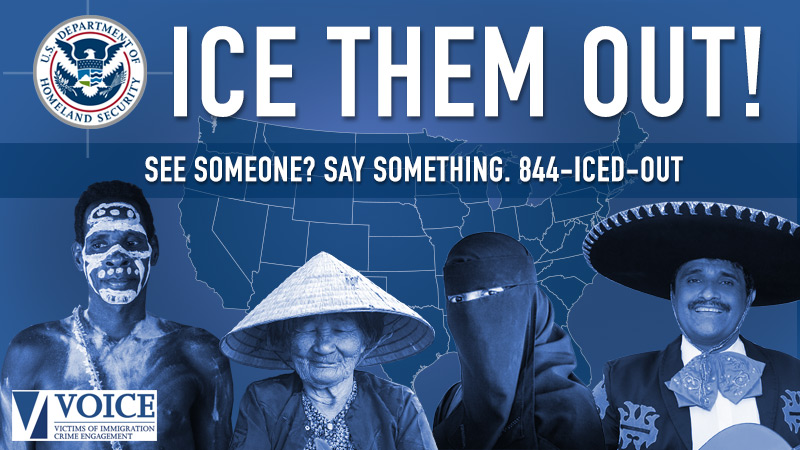How President Trash's Administration Is Using Local Cops to Widen Its Non-White Immigration Dragnet & Skin Color Targeting Program
/
From [HERE] A controversial program that allows state and local law enforcement to partner with federal immigration officials is rapidly expanding under the Trump administration. According to a recent Reuters story, the number of departments participating in so-called 287(g) agreements has doubled within the past 10 months, and 38 more jurisdictions have expressed interest in joining the program.
The expansion shows that the Department of Homeland Security is increasingly turning to local law enforcement to arrest and deport undocumented immigrants—a strategy previously outlined in a February memo from then-DHS Secretary John Kelly, who called the program a “a highly successful force multiplier” and “critical to an effective enforcement strategy” while directing senior immigration officials to immediately engage with any interested jurisdictions. A Freedom of Information Act request from Reuters revealed that DHS officials have reached out to “scores” of jurisdictions about participating in 287(g).
“It fits right into what Trump wants to do,” says Bill Ong Hing, an immigration law professor at the University of San Francisco. “He promised to establish an army charged with rounding up and deporting undocumented immigrants. [287(g) agreements] are a convenient way for him to expand that deportation force.”
Many of the police departments that have joined or expressed interest in joining 287(g) are located in towns with small populations, and three-quarters of them are located in counties that voted for Trump during the 2016 election, according to Reuters. ICE now has 287(g) agreements with 60 law enforcement agencies in 18 states, with a large share of those agencies in Texas.
287(g) has had a long and well-documented history of problems, and the ACLU has called it “one of the worst federal immigration enforcement programs.” Expanding it would have a “really chilling effect,” says Shiu-Ming Cheer, a senior staff attorney at the National Immigration Law Center. “Immigrants will start seeing law enforcement as deportation agents. It’s going to create a wider sense of fear.”
What does 287(g) allow?
Named after a section of the Immigration and Nationality Act, 287(g) allows state and local police departments to enter into formal partnerships with Immigration and Customs Enforcement (ICE) to perform some federal immigration enforcement duties, such as checking immigration records and issuing immigration detainers.
In the past, 287(g) agreements centered around a “task force officer” model that allowed police to question and arrest individuals they suspected of being undocumented. But because of concerns that the program enabled racial profiling, ICE revised the program and allowed all task force model agreements to expire at the end of 2012. Since then, all 287(g) agreements have been limited to a “jail enforcement” model, where deputized officers can interrogate arrested individuals about their immigration status and issue immigration detainers on inmates.
Kelly’s February memo signaled that immigration officials should consider agreements that provided the “most effective” enforcement, including the task force officer model and a hybrid model that included both jail and task force operations. According to Reuters, eight jurisdictions have expressed interest in using the task force model. Three, including the controversial Milwaukee County Sheriff’s Office headed by David Clarke, say they want to use both the task force and jail model. Immigrants rights groups have already begun protesting sheriffs considering 287(g) agreements, including in Milwaukee and in Knox County, Tennessee.
Does it lead to more deportations?
According to ICE, 287(g) “led to the identification of more than 402,000 removable aliens” from January 2006 to September 2015, primarily through jail enforcement. An analysis of ICE data by the Marshall Project found that the agreements led to more than 175,000 deportations between 2006 and 2013.
ICE officials state that 287(g) agreements are supposed to help ICE target and deport undocumented immigrants with serious criminal convictions. However, 287(g) has been found to lead to more arrests of immigrants with lower-level charges, such as traffic violations or misdemeanors. A 2009 Government Accountability Office report criticized ICE for failing to communicate its objectives to partners, and that the agreements were being used to arrest immigrants for minor crimes as a result. A 2011 analysis by the Migration Policy Institute, a nonpartisan think tank, found that half of the undocumented immigrants who were issued detainers through 287(g) had been arrested on traffic and misdemeanor charges, as opposed to serious criminal charges.
Also, the number of jurisdictions participating in 287(g) has changed considerably over the years. The program grew rapidly in 2007, reaching its peak in 2010 with 70 jurisdictions. But following criticism of the program, only 32 agreements remained by late 2016.
What are other problems associated with the program?
The task force model was most famously used—and abused—by former Sheriff Joe Arpaio of Maricopa County, Arizona, who sent his officers on raids and “sweeps” to arrest undocumented immigrants. A 2009 Department of Justice investigation into the Maricopa County Sheriff’s Office found that police officers were routinely engaging in unconstitutional practices and racial profiling: Latino drivers were four to nine times more likely to be stopped than non-Latino drivers in the county.
Another DOJ investigation in 2012 concluded that the Alamance County Sheriff’s Office in North Carolina engaged in unconstitutional and discriminatory practices related to 287(g), and that a “culture of discriminatory practices against Latinos pervades” the sheriff’s office. The county’s 287(g) agreement was terminated after the investigation. In June, however, Sheriff Terry Johnson, who was cited by the DOJ as fostering and directing this discrimination, said that he had been approached by ICE to rejoin the program and “immediately agreed,” according to the Times-News, a local paper in Burlington, North Carolina. The Alamance County Sheriff’s Office is on Reuters’ list of jurisdictions who have expressed interest in 287(g), though no formal agreement has been publicly posted.
Experts and police chiefs have also expressed concern that 287(g) agreements can create a climate of fear for immigrants and erode trust between immigrants and law enforcement officers. The Major Cities Chiefs Association, an association of police chiefs and sheriffs in the largest cities in the United States and Canada, has repeatedly expressed concerns over police cooperating with federal immigration enforcement officials. In a 2013 statement, the MCCA noted that police enforcing federal immigration law “undermines the trust and cooperation with immigrant communities which are essential elements of community oriented policing.” [MORE]













































































































































































































































































